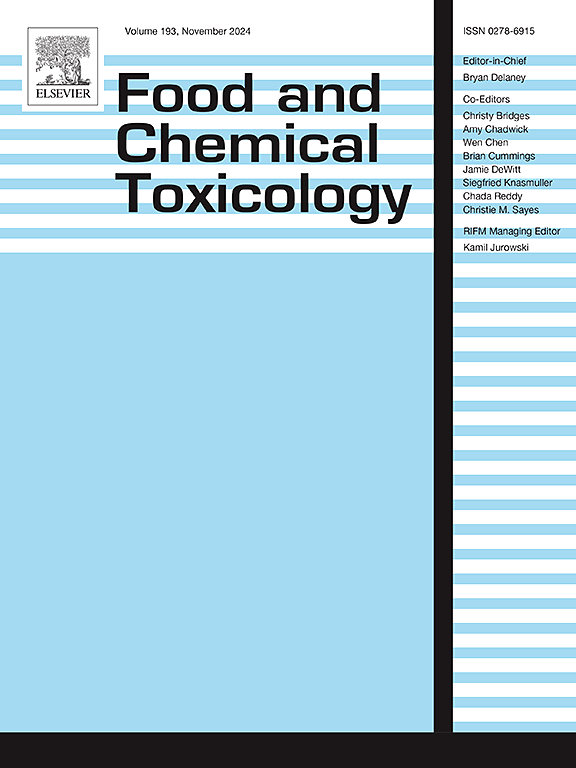Utility of in vitro assay data in read-across prediction of nongenotoxic carcinogenicity of pesticides for cytotoxicity-related rat tumors
IF 3.9
3区 医学
Q2 FOOD SCIENCE & TECHNOLOGY
引用次数: 0
Abstract
Developing alternative methods for rat carcinogenicity studies remains challenging. This study aimed to establish a read-across method to predict nongenotoxic carcinogenicity in rats using molecular descriptors and in vitro assays. Based on 2-year rat carcinogenicity study results of agrochemicals, 80 compounds that caused benign or malignant tumors in the liver, thyroid, testis, uterus, ovary, breast, nasal cavity, stomach, or bladder/urethra and 46 compounds that did not were selected and subjected to cell-based cytotoxicity assays. Here, we focused on tumors associated with epithelial cell injury (nasal cavity, stomach, and bladder/urethra tumors). The read-across prediction was performed using neighboring substances, which were selected based on the Euclidean distance between the substances calculated using molecular descriptors. In some cases, neighboring substances were further selected based on the concordance of the in vitro assay results. The selection of neighboring substances based on the carcinogenicity-relevant descriptors and then on the cytotoxicity assay data improved the prediction accuracy (balanced accuracy: 0.752–0.821) compared to the accuracy with substances selected based on unselected descriptors alone (balanced accuracy: 0.294–0.582). These results suggest that the combined use of carcinogenicity-relevant descriptors and in vitro assays related to carcinogenic mechanisms is useful for read-across prediction of cytotoxicity-related tumors in rats.
体外分析数据在跨读预测农药对细胞毒性相关大鼠肿瘤的非基因毒性致癌性中的应用
开发大鼠致癌性研究的替代方法仍然具有挑战性。本研究旨在建立一种通过分子描述符和体外实验预测大鼠非遗传毒性致癌性的跨读方法。根据2年的农用化学品大鼠致癌性研究结果,选择80种可引起肝脏、甲状腺、睾丸、子宫、卵巢、乳房、鼻腔、胃或膀胱/尿道良性或恶性肿瘤的化合物和46种未引起良性或恶性肿瘤的化合物进行基于细胞的细胞毒性试验。在这里,我们主要关注与上皮细胞损伤相关的肿瘤(鼻腔、胃和膀胱/尿道肿瘤)。通过使用分子描述符计算出的物质之间的欧几里得距离来选择相邻的物质来进行读取预测。在某些情况下,根据体外测定结果的一致性,进一步选择邻近物质。与仅根据未选择的描述符选择物质的准确性(平衡精度:0.294-0.582)相比,根据致癌性相关描述符选择邻近物质,然后根据细胞毒性测定数据提高了预测准确性(平衡精度:0.752-0.821)。这些结果表明,结合使用与致癌性相关的描述符和与致癌性机制相关的体外试验,对于大鼠细胞毒性相关肿瘤的跨读预测是有用的。
本文章由计算机程序翻译,如有差异,请以英文原文为准。
求助全文
约1分钟内获得全文
求助全文
来源期刊

Food and Chemical Toxicology
工程技术-毒理学
CiteScore
10.90
自引率
4.70%
发文量
651
审稿时长
31 days
期刊介绍:
Food and Chemical Toxicology (FCT), an internationally renowned journal, that publishes original research articles and reviews on toxic effects, in animals and humans, of natural or synthetic chemicals occurring in the human environment with particular emphasis on food, drugs, and chemicals, including agricultural and industrial safety, and consumer product safety. Areas such as safety evaluation of novel foods and ingredients, biotechnologically-derived products, and nanomaterials are included in the scope of the journal. FCT also encourages submission of papers on inter-relationships between nutrition and toxicology and on in vitro techniques, particularly those fostering the 3 Rs.
The principal aim of the journal is to publish high impact, scholarly work and to serve as a multidisciplinary forum for research in toxicology. Papers submitted will be judged on the basis of scientific originality and contribution to the field, quality and subject matter. Studies should address at least one of the following:
-Adverse physiological/biochemical, or pathological changes induced by specific defined substances
-New techniques for assessing potential toxicity, including molecular biology
-Mechanisms underlying toxic phenomena
-Toxicological examinations of specific chemicals or consumer products, both those showing adverse effects and those demonstrating safety, that meet current standards of scientific acceptability.
Authors must clearly and briefly identify what novel toxic effect (s) or toxic mechanism (s) of the chemical are being reported and what their significance is in the abstract. Furthermore, sufficient doses should be included in order to provide information on NOAEL/LOAEL values.
 求助内容:
求助内容: 应助结果提醒方式:
应助结果提醒方式:


